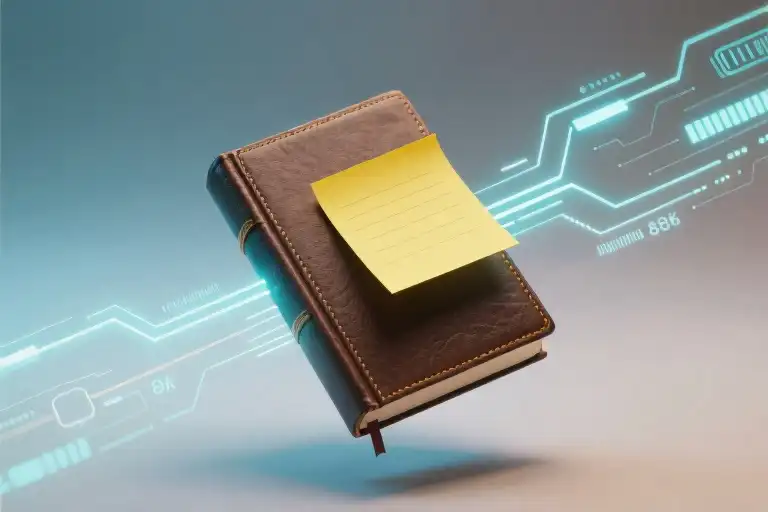Relationships aren’t always the romantic comedy we signed up for. Sometimes they play out more like a National Geographic documentary—complete with baffling behavioral patterns and subtitles that read: ‘Here we observe the human male responding to emotional vulnerability with the enthusiasm of someone checking a weather app.’
In this peculiar ecosystem of modern love, two distinct species have evolved: The Open Book and The Post-it Note Partner. One comes with footnotes, highlighted passages, and a fully searchable emotional index. The other communicates in cryptic doodles that leave you wondering if that’s supposed to be a smiley face or a deflating balloon.
The Open Book (n.):
- Processes childhood trauma into TED Talk-worthy insights
- Maintains real-time emotional analytics (“Current mood: 60% nostalgic, 30% caffeinated”)
- Speaks in complete vulnerability sentences with proper citations
The Post-it Note Partner (n.):
- Stores feelings in temporary memory (deleted upon reboot)
- Communicates via minimalist art (see: lopsided sun drawing)
- Default response to existential crises: “Huh. Weird.”
When these two communication formats collide, it creates the romantic equivalent of trying to stream a 4K emotional documentary through dial-up internet. She’s sending detailed emotional data packets with metadata attachments. He’s responding with the equivalent of a system notification: “Update available (maybe later).”
This isn’t about blame—it’s about compatibility modes. Some of us run on macOS-level emotional processing power, while others are out here thriving like those indestructible Nokia phones from 2002. Simple? Yes. Limited? Perhaps. But you can’t argue with that battery life.
The real relationship hack isn’t trying to turn post-it notes into novels. It’s learning to speak each other’s file formats. Because love in the digital age means figuring out how to make your EPUB heart compatible with someone whose emotions still run on Windows 95.
The Personality Archives: A Catalog of Modern Partner File Formats
Relationships in the digital age have spawned new species of emotional communicators. Forget zodiac signs or love languages—the real taxonomy lies in how we organize (or fail to organize) our emotional data. Meet the three most common operating systems in today’s romantic ecosystem.
The Hardcover Encyclopedia Partner
File Extension: .BOOK
Storage Capacity: Unlimited (with occasional corrupted childhood trauma files)
Key Features:
- Fully indexed emotional catalog
- Hyperlinked cross-references to past experiences
- Automatic update function for new insights
These walking libraries don’t just wear their hearts on their sleeves—they publish quarterly emotional reports with annotated bibliographies. When they say “let’s talk about our feelings,” they mean a 90-minute TED Talk complete with PowerPoint slides on attachment theory.
“I’m not oversharing,” says the book-type partner, “I’m providing full transparency with searchable metadata.”
The Post-It Note Partner
File Extension: .PNG (because depth isn’t their format)
Storage Capacity: 3″ x 3″ of emotional real estate
Key Features:
- Single-emoji emotional vocabulary
- Temporary adhesive (emotions expire by noon)
- High risk of being accidentally thrown away
Their emotional responses come in three varieties: smiley face, frowny face, and the rare “hungry burger” doodle. When you share your existential dread, they’ll respond with the emotional equivalent of “K thx bye” scribbled on a neon square.
Diagnostic Tip: If your partner’s emotional range fits comfortably on office stationery, you may be dating a human sticky note.
The PDF Partner
File Extension: .PDF (Pretty Damn Fixed)
Storage Capacity: Pre-set with no edit function
Key Features:
- Password-protected emotional sections
- “This document contains no editable text” energy
- Perfectly preserved 2012 emotional settings
These partners come with all the appearance of emotional availability—beautifully formatted, professionally typeset—until you realize you can’t actually interact with the content. Highlight all you want, the text won’t budge.
Pro Tip: Trying to edit a PDF partner’s emotional settings? You’ll need the password they forgot in 2008.
Office Supply Compatibility Test
Which workstation best describes your partner’s emotional output?
- When you share vulnerable feelings, they respond with:
a) An annotated bibliography of related experiences
b) A sticky note saying “that’s rough buddy”
c) Error message: “File cannot be modified” - During arguments, their communication style resembles:
a) Wikipedia edit wars
b) Doodles in the meeting minutes
c) A locked “read-only” document - Their emotional memory operates like:
a) Cloud storage with perfect recall
b) A desk covered in half-peeled sticky notes
c) A corrupted hard drive with missing sectors
Scoring: Mostly A’s? You’ve got a library card. B’s? Stock up on Post-Its. C’s? Enjoy your tamper-proof emotional contract.
Next Chapter Preview: When your emotionally searchable database tries to sync with a partner running on dial-up connection speeds…
The Autopsy Room of Failed Conversations
Let’s examine three classic communication specimens under our humor microscope. These dialogues may look familiar – like finding your childhood photos in a thrift store, equal parts nostalgic and horrifying.
Specimen #1: The Emotional Weather Report
Scene: Sunday morning breakfast table
Her: “I had this dream where I was drowning in a sea of unfinished tasks… it’s clearly about my fear of inadequacy at work and abandonment issues from childhood.” (Emotional bandwidth: 4K Ultra HD)
Him: “Huh. Want the last pancake?” (Response resolution: 8-bit pixel art)
Diagnosis: Classic “Empathy Module 404” error. His emotional processing software received the signal but defaulted to Basic Survival Mode. This often occurs when the system detects complex feelings that might require more than 5% CPU capacity.
Specimen #2: The Binary Code Romance
Scene: Post-work decompression time
Her: “Tell me something nice about us.” (Request type: Emotional Wi-Fi signal boost)
Him: “We exist in the same spacetime continuum?” (Signal strength: 1 bar)
Diagnosis: Male Communication Protocol (MCP) automatically converts poetic requests into astrophysics statements when romance servers are overloaded. The system isn’t broken – it’s just running on dial-up settings while she’s trying to stream 4K emotions.
Specimen #3: The Emotional CAPTCHA Test
Scene: Midnight existential crisis
Her: “Do you ever feel like we’re becoming strangers?” (Encryption level: Military grade)
Him: “Zzz… huh? We live together.” (Decryption key: LiteralDictionary.exe)
Diagnosis: Failed authentication. His emotional firewall mistook vulnerability for a phishing attempt. Common issue when one partner runs Night Owl OS while the other operates on Early Bird 1.0.
Emergency Toolkit for the Emotionally Stranded
(Sidebar for male readers who just recognized themselves in these specimens)
| When she says… | Try responding… | Instead of… |
|---|---|---|
| “I feel invisible” | “Help me see what you’re seeing” | “But you’re literally right here” |
| “You never listen” | “I want to understand – can you replay that for me?” | Nods while mentally sorting fantasy football stats |
| “We need to talk” | “I’m getting my notepad” (actual notepad optional) | Pretending to receive urgent carrier pigeon message |
Pro Tip: These aren’t “correct answers” – they’re emotional USB adapters to bridge incompatible connection ports. Sometimes all her system needs is confirmation that you’re trying to install the latest empathy update.
Post-Mortem Insights
These communication fossils reveal a universal truth: We’re all running different emotional operating systems. Her detailed memoir app keeps crashing his minimalist sticky-note processor not because either is defective, but because nobody reads the compatibility fine print when falling in love.
The good news? Even the most mismatched systems can create joint files – it just takes recognizing when to switch from WiFi to Bluetooth, or accept that some messages will always need extra compression to transmit properly.
The STEM of Emotional Black Holes
Ever tried streaming a 4K movie on dial-up internet? That’s exactly what emotional communication feels like when your Wi-Fi signal strength varies dramatically between partners. Welcome to relationship physics 101, where we analyze emotional data transmission through the unflinching lens of science.
The Wi-Fi Signal Theory of Emotional Availability
Some partners broadcast emotions like strong 5G signals – clear, consistent, and capable of handling multiple data streams simultaneously. Others operate like that one frustrating bar in your apartment that only gets spotty reception if you stand on one leg near the refrigerator.
Key connectivity issues include:
- Signal strength fluctuation: His emotional availability drops during football season like clockwork
- Bandwidth limitations: That 3MB attachment of your feelings? His inbox only accepts 1MB files
- Latency problems: Your “I need to talk” message sent at 9PM gets delivered with a 48-hour delay
Pro tip: The “Have you tried turning it off and on again?” approach works surprisingly well for emotional systems too. Sometimes all it takes is a good night’s sleep to reset the connection.
Storage Capacity & Cache Management
Her emotional storage resembles a meticulously organized cloud server with:
- Color-coded memory folders
- Cross-referenced experience indexes
- Automatic backup systems
His system? A 1998 floppy disk with “Stuff” scribbled in Sharpie. The infamous “I forgot” isn’t always avoidance – sometimes it’s literal data loss from insufficient storage allocation.
Common storage errors:
- Anniversary dates saved in temporary cache (automatically clears after 24h)
- Important conversations saved as “Draft” instead of “Sent”
- Critical updates requiring manual installation (“Yes honey, I should’ve noticed the new haircut”)
System Compatibility Report
Our lab tests reveal most relationship conflicts stem from fundamental operating system differences:
| Her System | His System |
|---|---|
| macOS Monterey | Windows 98 |
| Always updated | “Remind me later” for 7 years |
| 1TB emotional storage | 256MB (mostly for sports stats) |
| Automatic vulnerability patches | Firewall permanently enabled |
Crash prevention protocol:
- Recognize you’re running different emotional firmware
- Create shared “file formats” for important communications
- Schedule regular “system updates” (aka date nights)
Remember: No operating system is inherently wrong – they just speak different programming languages. The secret is learning to be bilingual in love.
The Non-Technical Upgrade Guide for Emotional Systems
When your relationship feels like a vintage computer trying to run modern software, it’s not about replacing the entire operating system—it’s about strategic updates. Think of this as the IKEA manual for emotional compatibility, where we’ll help you assemble solutions without those mysterious leftover screws.
Step 1: Magnetic Post-it Conversion Kit
That flimsy emotional Post-it? Let’s give it some staying power:
graph TD
A[Single-Smile Post-it] --> B{Upgrade Module}
B --> C[Sticky-Backed Magnet]
B --> D[Emoji Sticker Pack]
C --> E[Refrigerator-Ready Memo]
D --> F[Multi-Dimensional Expressions]Pro Tip: Start small—replace that crooked smiley with:
- 🫂 for “I’m here”
- 🌪️ for “I’m overwhelmed”
- 🔄 for “Let’s revisit this later”
Step 2: Cache Clearing Protocol
When emotional responses freeze like an overloaded browser:
- Ctrl+Alt+Del the conversation:
- “Pause. My emotional RAM is full”
- “Let me reboot that thought”
- Create emotional temp files:
- “For now, just know I care” (saves progress)
- “I need 15 minutes to process” (prevents crashes)
Warning: Avoid fake “system updates” like:
- ❌ “Fine” (when not fine)
- ❌ “Whatever you want” (with eye roll)
Step 3: Cross-Platform Communication
Bridging the book-to-Post-it divide:
| Book Language | Post-it Translation |
|---|---|
| “I need emotional validation” | “Am I reading this chapter right?” |
| “Let’s discuss our attachment styles” | “Remember when your dad forgot pickup? Yeah.” |
Toolkit Addition:
- 📌 Red flag post-its (for non-negotiables)
- 📌 Green light post-its (for “more of this!”)
Safety Labels (Read Before Installation)
⚠️ This upgrade won’t:
- Turn poetry into spreadsheets
- Make emotions 100% legible
✅ This upgrade will:
- Prevent emotional data corruption
- Add basic search functionality to that smiley face
Remember: Even the best systems need occasional troubleshooting. When you find yourself speaking Shakespeare to a rubber duck emoji, take comfort knowing that love sometimes means learning each other’s emotional programming languages—one sticky note at a time.
The Post-It Note Rescue Mission
So here we are at the end of our relationship anthropology expedition. You’ve identified your partner’s file format (congratulations on diagnosing that Windows 95 emotional operating system), survived the Wi-Fi dead zones of communication, and now hold the metaphorical toolkit for your Post-It Note companion. But before we wrap up this National Geographic special on modern love, let’s talk upgrades.
The Emoji Upgrade Protocol
Start small with what I call the “Post-It Plus” system. That single doodled smiley face? Give it company. Next time your partner leaves their characteristic minimalist emotional artifact, add:
- A color (blue for “I noticed you took out the trash”)
- An emoji (🌧️ when they say “sounds like a busy day” to your existential crisis)
- One adjective (“Your microwave dinner was… brave”)
This isn’t about transforming your Post-It partner into Tolstoy overnight. Think of it as helping them upgrade from System 1.0 to 1.1 – still recognizable, but with slightly better emotional resolution.
Relationship Patch Notes
Every software needs updates, and so does emotional communication. Try these micro-adjustments:
- The Changelog: Share one actual feeling per day like it’s a software update (“Today’s patch: Fixed overreaction to slow walkers. Still debugging insecurity about parallel parking.”)
- Error Reporting: When translations fail (“You mean ‘fine’ the way a sinking ship is ‘fine’?”), use humor as your debug tool
- Bandwidth Check-ins: Schedule low-pressure connection times (“Wi-Fi signal strong enough for a feelings download right now?”)
The Museum of Miscommunication
Remember: those frustrating Post-It moments will eventually become your relationship’s inside jokes. Frame them mentally as exhibits in your private museum:
- Gallery 1: “The Snooze Button Response to Emotional Crises (2019-2023)”
- Wing 2: “Early Attempts at Emotional Indexing (See: The Great ‘Where Do You See Us in 5 Years’ Crash of 2020)”
When to Call Tech Support
While humor helps navigate emotional labor imbalances, recognize when professional help is needed:
🚩 Your “Post-It” hasn’t shown any new content in months
🚩 All your emoji upgrades get auto-deleted
🚩 The emotional Wi-Fi has been “down for maintenance” since the Bush administration
Relationship counseling isn’t failure – it’s like bringing in a senior developer when your home fixes aren’t resolving the bugs.
Your Turn
Now over to you, our intrepid emotional anthropologists:
- What creative upgrades have you tried with your Post-It partner?
- Share your best “translation fails” from the field
- Any fellow books out there who successfully co-authored with a Post-It?
Drop your findings in the comments – let’s crowdsource solutions to this universal compatibility challenge. And remember: whether you’re a leather-bound volume or a neon sticky note, all love stories deserve their own weird, wonderful glossary of terms.
For those needing deeper support, emotional tech support is available at [local counseling resources]. Your operating system deserves proper maintenance.





